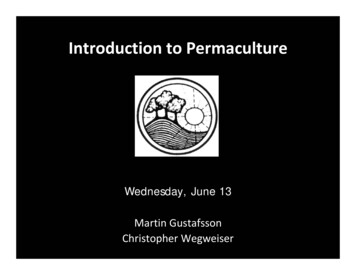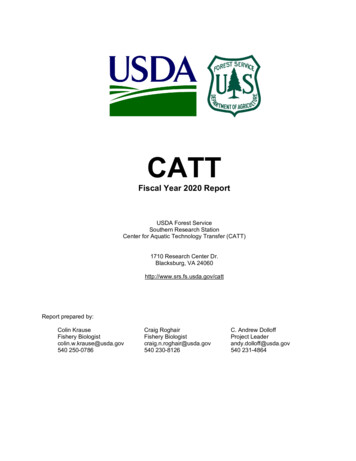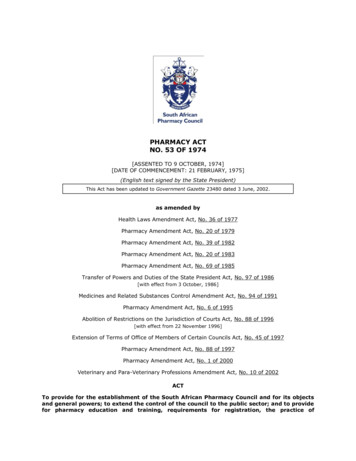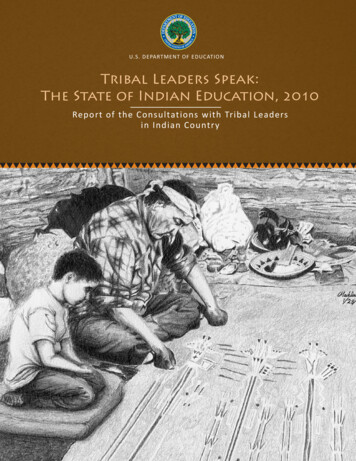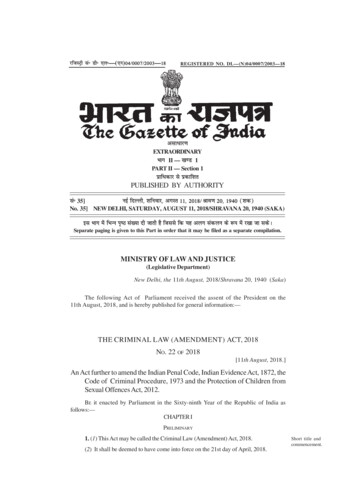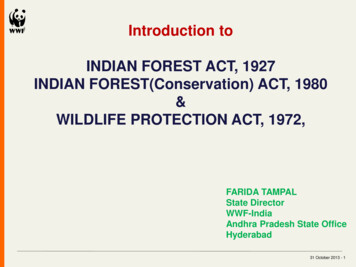
Transcription
Introduction toINDIAN FOREST ACT, 1927INDIAN FOREST(Conservation) ACT, 1980&WILDLIFE PROTECTION ACT, 1972,FARIDA TAMPALState DirectorWWF-IndiaAndhra Pradesh State OfficeHyderabad31 October 2013 - 1
Forest The word forest is derived from a Latin word “ Foris”means Outside Forest are one of the most important naturalresources of the earth. Approximately 1/3rd of the earth’s total area iscovered by forests31 October 2013 - 2
INDIAN SCENARIO In India forest cover Overall, 21.02% of the country's geographical area isnow under green cover (as per 2009* data) The total forest cover in India is6,90,899 km2 Forest cover in India is defined as all lands, more than one hectare in areawith a tree canopy density of more than 10%.31 October 2013 - 3
31 October 2013 - 4
TYPES OF FORESTS IN INDIAMOIST TROPICAL FORESTa)Tropical wet evergreen: Western(Maharashtra, Karnataka, Kerala)Ghatsa)b) Tropical semi evergreen: Lower hills of d)Damp Forests: Sunder bans, Bengal delta, andAndaman.d)Dehradun,b)c)31 October 2013 - 5
Cont .DRY TROPICAL FORESTSa) Tropical dry deciduous: Madhya Pradesh,Uttar Pradesha)b) Tropical thorn forest: Delhi, Punjab, Gujaratc)Tropical dry evergreen: Eastern Ghats(Andhra Pradesh, Tamil Nadu)b)c)31 October 2013 - 6
MONTANA SUB TROPICAL FORESTSCONIFEROUS FORESTSa) Subtropical broad: Shillong, Nilgirisb) Subtropical pine forest: Arunachal Pradesh,Kashmira)c) Sub Tropical dry evergreen: Foot Hills ofHimalayas.b)c)31 October 2013 - 7
MONTANA TEMPERATE FORESTSa)b)c)Montana Wet temperate: Nilgiri, Palmi HillsHimalayan wet temperate: Assam, Himachal PradeshHimalayan dry temperate: Kashmir31 October 2013 - 8
SUB ALPINE FORESTSa) Moist alpine scrub- high Himalayasb) Dry alpine scrub: Sikkim31 October 2013 - 9
Among the 16 different forest types of the country, the most common is Tropical dry deciduous (38.7%) Tropical moist deciduous (30.9%) Tropical thorn (6.9 %)These 3 types of tropical deciduous forests accounts for more than 76.5 % offorest area in India. Nearly 96 % of forests are owned by government and, 2.6% by corporate bodies and rest are in private ownership.31 October 2013 - 10
TYPES OF FORESTS IN INDIA31 October 2013 - 11
INDIAN FOREST ACT, 1927 The Indian Forest Act, 1927 was largely based on previous IndianForest Acts implemented under the British. The first and most famous was the Indian Forest Act of 1878. The preamble to the Indian Forest Act, 1927 states that the Act seeks toconsolidate the law relating to forests, the transit of forest produce andthe duty that can be levied on timber and other forest produce. It also defines the procedure to be followed for declaring an area to bea Reserved Forest, a Protected Forest or a Village Forest. It defines what is a forest offence, what are the acts prohibited inside aReserved Forest, and penalties leviable on violation of the provisions ofthe Act.31 October 2013 - 12
INDIAN FOREST ACT, 1927It has 86 Sections and it has been divided into 13 chapters relating toi) Preliminary,ii) Reserved Forests,iii) Village Forests,iv) Protected Forests,v) the Control Over Forests and Lands not Being the Property of Government,vi) the Duty on Timber and Other Forest Produce,vii) the Control of Timber and Other Forest Produce in Transit,viii) the Collection of the Drift and Stranded Timber,ix) Penalties and Procedure,x)Cattle-Trespass,xi) Forest Officers,xii) Subsidiary Rules,&xiii) Miscellaneous.31 October 2013 - 13
INDIAN FOREST ACT, 1927 In the Indian Forest Act, 1927, a striking feature is the absence of anydefinition of forest or forest land. The attempt of the Supreme Court to assign a meaning to the term ‘forest’ asper the dictionary meaning has seen a spate of interventions in the Court dueto its wide ambit. Forest as per the above definition, may include private, common pasture, orcultivable land.31 October 2013 - 14
INDIAN FOREST ACT, 1927Section 2(4) of this Act provides definitions for the forest-produce and includes:the following whether found in, or brought from a forest, that is to say timber, charcoal, catechu, wood-oil, resin, natural varnish, bark, lac, mahuaflowers, mahua seeds, kuth and myrabolamsandthe following when found in, or brought from, a forest or not, that is to say trees and leaves, flowers and fruits, and all other parts or produce nothereinbefore mentioned, of trees, plants not being trees (including grass, creepers, reeds and moss), and allparts or produce of such plants, wild animals and skins, tusks, horns, bones, silk, cocoons, honey and wax, andall other parts or produce of animals, and peat, surface soil, rock and minerals (including lime-stone, laterite, mineraloils, and all products of mines or quarries).31 October 2013 - 15
INDIAN FOREST ACT, 1927This Act establishes three categories of 1 October 2013 - 16
INDIAN FOREST ACT, 1927RESERVE FOREST The most restricted category is ‘Reserved Forest’. These forests may be constituted by the State Government on any forest land orwaste land which is the property of the Government or on which the Governmenthas proprietary rights. Where the land is not forest land or waste land, as said above, any notificationissued by the Government (under Section 20 of the IFA) declaring the land asreserve forest will be without jurisdiction and a Civil Court would be competent toquash such notification. On the other hand, where forest land or waste land is the property of theGovernment, the Forest Settlement Officer shall proceed to determine subordinaterights in the land before a final notification is issued making the area a reservedforest. In reserved forests, most uses by local people are prohibited, unless specificallyallowed by a Forest Officer in the course of settlement.31 October 2013 - 17
INDIAN FOREST ACT, 1927PROTECTED FOREST The State Government is empowered to constitute any land other than reservedforests as protected forests over which the Government has proprietary rights. Under ‘Protected Forests’, the Government retains the power to issue rulesregarding the use of such forests, but in the absence of such rules, most practicesare allowed. Among other powers, the State retains a power to reserve the specific treespecies in the protected forests. This power has been used to establish State control over trees, whose timber,fruit or other non-wood products have revenue-raising potential.31 October 2013 - 18
INDIAN FOREST ACT, 1927VILLAGE FOREST A third classification is ‘village forests’ in which the State Government mayassign to ‘any village community the rights of Government to or over any landwhich has been constituted a reserved forest’. The State Government may also make rules for regulating the management ofsuch forests. Little use has been made of this provision. The terms ‘village forest’ and ‘forest village’ are interchangeably used - however,they must be distinguished from one another. While ‘village forest’ is a legal category under the Indian Forest Act, 1927, ‘forestvillage’ is an administrative category. Although the latter is recognised by the Forest Department, the revenue benefitscannot accrue to such villages as they are not technically under the revenuedepartments.31 October 2013 - 19
INDIAN FOREST ACT, 1927PROCEDURE FOR THE SETTLEMENT OF RIGHTS The Act establishes an elaborate procedure for the settlement of rights when a reserved forest isintended to be constituted. The settlement procedures require the Forest Officer called the Forest Settlement Officer (FSO) toconsider the claims of the local inhabitants to certain usage rights, but leave ample discretion for himto relocate, revise or discontinue such practices. The State is first required to issue a notification declaring its intention to reserve a certain tract ofland, and appoint an FSO to inquire into the existence of any alleged rights in favour local inhabitants. The inquiry by the FSO should not be confined to merely recording evidence produced by theclaimants or ascertainable from the records of the Government. The FSO may call for an examination of any person who, he may think, has the knowledge of thefacts, including the evidence of any person likely to be acquainted with the same (Section 6). No new rights in the notified land may arise after such a notification has been issued, and thoseclaiming any pre-existing right have a period of at least three months to appear and assert such aright, and to make a case for compensation. Generally, rights which are not asserted during that period are extinguished, although there areprovisions in extraordinary cases for later assertions until the final reservation order is published.31 October 2013 - 20
INDIAN FOREST ACT, 1927The Indian Forest Act anticipates three types of claims in forests proposedto be reserved.FIRSTA forest dwellermight lay claim toownership of land.SECONDA claim may beasserted for rightsto pasture or forestproduce.FINALSpecial provisionsapply to the practiceof shiftingcultivation, whichthe ForestSettlement Officermay prohibit withoutany compensation.The Scheduled Tribes and Other Traditional Forest Dwellers (Recognition of ForestRights) Act, 2006, recognizes the rights of forest-dwelling Scheduled Tribes and othertraditional forest dwellers over the forest areas inhabited by them and provides aframework for according the same.31 October 2013 - 21
INDIAN FOREST ACT, 1927OFFENCES UNDER THE FOREST ACT On account of their peculiarity, differ from those under the Indian Penal Code in the sensethat as a result of the former, no one is personally aggrieved or affected by the injury inflictedupon the forests, and the vast expanse of it makes the detection of offences difficult. Forest Offence has been defined under Section 2(3) of the Indian Forest Act, 1927, to mean‘an offence punishable under the Indian Forest Act, 1927 or rules made there under. Forest offences have been classified into two broad categories. Firstly, there are trivialoffences covered under Section 68, where offences may be disposed of by compounding(compromising with money). Secondly, there are offences which do not fall under the above category and they entailhigher punishment, which includes imprisonment, confiscation of private forest produce, tools,vehicle and cattle, etc., and in addition, the recovery of an amount equal to the damage done tothe forest as compensation in case of offences relating to reserve forest (Section 26). A third category of forest offences relates to cattle trespass. Such offences are disposed ofunder the Cattle Trespass Act, 1871.31 October 2013 - 22
INDIAN FOREST ACT, 1927OFFENCE– “Forest lele/journalpublications/slele 14 Rosencranz & LeleEPW Feb 2008.pdf31 October 2013 - 23
INDIAN FOREST(Conservation) ACT, 1980 The Parliament has enacted the Forest (Conservation) Act, 1980, to checkfurther deforestation and conserve forests and to provide for mattersconnected therewith or ancillary or incidental thereto. This Act has five Sections which deal with conservation of forests. The Act was enacted with the twin objectives under Section 2 of restrictingthe use of forest land for non-forest purposes, and preventing the dereservation of forests that have been reserved under the Indian Forest Act,1927. However, in 1988 the Act was further amended to include two new provisionsunder Section 2, where it sought to restrict leasing of forest land to privateindividuals, authority, corporations not owned by the Government, and toprevent clear felling of naturally grown trees.31 October 2013 - 24
INDIAN FOREST(Conservation) ACT, 1980 The Act empowers the Central Government to constitute a committee to advisethe Government with a grant of approval under Section 2, as also on any othermatter connected with the conservation of forest and referred to it by the CentralGovernment. The Act provides for the punishment of imprisonment, extendable to fifteen daysfor the contravention of the provisions of the Act. The Act provides for punishment of offenders from the Government Departments,including Head of the Departments and authorities. However, these persons can escape criminal liabilities if they can prove that:1. The offence was committed without their knowledge,2. They had exercised all due diligence to prevent the committing of such offence.31 October 2013 - 25
WILDLIFE IN INDIA31 October 2013 - 26
HOT SPOTS OF INDIAEastern HimalayasEndemism 156110Western Ghats31 October 2013 - 27
HIMALAYAS31 October 2013 - 28
WESTERN GHATS31 October 2013 - 29
DESERTS31 October 2013 - 30
NORTH EASTERN INDIA31 October 2013 - 31
COASTAL & MARINE31 October 2013 - 32
WILDLIFE PROTECTION ACT, 1972 The most significant legislation on wildlife protection which is based on theecosystem approach and a regulatory regime of command and control is the WildLife Protection Act, 1972. The objective of this enactment was three-fold.1. To have a uniform legislation on wild life throughout the country2. To establish a network of protected areas, i. e., national parks and sanctuaries3. To regulate illicit trade in wild life and its products.31 October 2013 - 33
WILDLIFE PROTECTION ACT, 1972History behind WLP Act, 1972The earliest codified law can be traced to 3rd Centuary B.C. when Ashoka, the King ofMaghadha, enacted a law in the matter of preservation of wild life and environment.But, the first codified law in India which heralded the era of laws for the wild life and protectionwas enacted in the year 1887 by the British and was titled as the Wild Birds Protection Act,1887 (10 of 1887).This Act enabled the then Government to frame rules prohibiting the possession or sale of anykinds of specified wild birds, which have been killed or taken during the breeding season.Again the British Government in the year 1912 passed the Wild Birds and Animals ProtectionAct, 1912 (8 of 1912) as the Act of 1887 proved to be inadequate for the protection of wildbirds and animals.The Act of 1912 was amended in the year 1935 by the Wild Birds and Animals Protection(Amendment) Act, 1935 (27 of 1935).31 October 2013 - 34
WILDLIFE PROTECTION ACT, 1972History behind WLP Act, 1972 After the Second World War the freedom struggle for India started taking itsshape and wild life was relegated to the background. But after independence, the Constituent Assembly in the Draft Constitution placed"Protection of Wild Birds and Wild Animals" at entry No.20 in the State List and theState Legislature has been given power to legislate. It was not till late 1960's that the concern for the depleting wild finallyaroused. The first comprehensive legislation relating to protection of wild life was passedby the Parliament and it was assented by the President on 9th September, 1972and came to be known as The Wild Life (Protection) Act, 1972.31 October 2013 - 35
WILDLIFE PROTECTION ACT, 1972The Wild Life Protection Act, 1972 has 66 Sections and has been divided intoseven chapters relating toi) Preliminary,ii) Authorities to be Appointed or Constituted under the Act,iii) Hunting of Wild Animals,iiiA) Protection of Specified Plants,iv) Sanctuaries, National Parks (Omitted 1991) and Closed Areas,ivA) Central Zoo Authority and Recognition of Zoos,v) Trade or Commerce in Wild Animals, Animal Articles and Trophies,vA) Prohibition of Trade or Commerce in Trophies, Animal Articles, Etc, derivedfrom Certain Animal,vi) Prevention and Detection of Offences,viA) Forfeiture of Property Derived from Illegal Hunting and Trade,vii) Miscellaneous, and Schedules:- I, II, III, IV, V, VI.31 October 2013 - 36
WILDLIFE PROTECTION ACT, 1972LIST OF AMENDING ACTS The constitution (Forty-second Amendment) Act, 1976. The Wild Life (Protection) (Amendment) Act, 1982 (23 of 1982). The Wild Life (Protection) (Amendment) Act, 1986 (28 of 1986) The Wild Life (Protection) (Amendment) Act, 1991 (44 of 1991). The Wild Life (Protection) (Amendment) Act, 1993 (26 of 1993). The Wild Life (Protection) (Amendment) Act, 2002 (16 of 2003) The Wild Life (Protection) (Amendment) Act, 200631 October 2013 - 37
WILDLIFE PROTECTION ACT, 1972WHY AN ACT FOR WILDLIFE? Rapid decline of India’s wildlife, one of the richest and most varied became acause of grave concern. In India wildlife conservation is a major challenge. Wildlife trafficking is a major threat for conservation. It has both local as well as a universal spread. Illegal wildlife trafficking is estimated to be billions of US dollars annually. It is reportedly next only to narcotics and illegal arms trafficking.31 October 2013 - 38
WILDLIFE PROTECTION ACT, 1972Preliminary2.Definitions:(1) Animal includes mammals, birds, reptiles, amphibians, fish other chordatesand invertebrates and also includes their young and eggs.(15) Habitat includes land water or vegetation which is natural home of wildanimals(16)Hunting with its grammatical variations and cognate (related to) expressionsincludes:i). Killing or poisoning of any wild animal orattempt to do socaptive animal and everyii). Capturing coursing, snaring, trapping driving or baiting any wild or captiveanimal and every attempt to do so.iii) Injuring or destroying or taking any part of the body of any such animals.(17) “Land” includes canals, creeks and other water channels, reservoirs, rivers,streams and lakes, whether artificial or natural.31 October 2013 - 39
WILDLIFE PROTECTION ACT, 1972Hunting of Wild Animals Sec.9: Prohibition of Hunting Sec.11: Hunting of wild animals to be permitted in certain cases Sec.12: Grant of permit for special purposes31 October 2013 - 40
WILDLIFE PROTECTION ACT, 1972Protected Areas under Wildlife (Protection) Act 1972 Sanctuaries (Section 26-A)National Parks( Section 35)Conservation reserves (Section 36-A)Community reserves (Section 36-C) Section-27 – Restriction on entrySection-28 – Grant of permit by CWLW fora) investigation and study of wildlifeb) Photographyc) Scientific researchd) TourismPermit subject to payment of prescribed feeSection-29 Destruction etc., Prohibited in Wildlife Sanctuary 31 October 2013 - 41
31 October 2013 - 42
WILDLIFE PROTECTION ACT, 1972Cont Section- 30 Causing of fire prohibitedSection- 31 Entry with weapon prohibitedSection- 32 Ban on injurious substancesSection-33 Control of sanctuaries.– CWLW may permit construction of roads– Buildings, fencing, barrier, gate– Regulate grazing– Permit habitat improvement works Section – 39.(1) Every –1. Wild animal2. Animal article3. Imported ivory4. Vehicle, weapon, tool, trap involved in offence shall be Govt. property(2) Any person who obtains such Govt. properties shall report to authorities within 48hrs.31 October 2013 - 43
WILDLIFE PROTECTION ACT, 1972Cont Section – 50 –(1) Any forest officer can enter, search, arrest and detain.(4) Any person detained shall be produced before a magistrate forthwith.(8) Officer not below ACF can issue search warrant, record evidence.(9) Any evidence recorded by the ACF before the accused shall be admissiblebefore a magistrate. However the State must notify either by name orby Rank through a Gazette Notification as prescribed in the Section50 Sub-section 8. Without a notification the admissibility of theconfessional statement may be challenged in the court of law.31 October 2013 - 44
WILDLIFE PROTECTION ACT, 1972Types of Wildlife Crime encountered Hunting with weapon, trap, snare, net,poison, livewire. Keeping live animals like Deer, tortoise,birds, snakes as pets. Keeping wild animal articles like skin,horns as trophies without possessioncertificate. Transporting wild animals and wild animalarticles without transit permit. Road accidents Train accidents Trade through internet31 October 2013 - 45
WILDLIFE PROTECTION ACT, 1972Illegal Trade through Internet www.ricepuller.com – offender name – B.Srinivas, MBA for trade inRed Sand boa (code : Double engine) www.olx.in - offender name – T.Karthik Reddy, B.Tech,M.Srinivasulu, MCA for trade in Indian soft shelled turtle(Code: Four wheeler)31 October 2013 - 46
WILDLIFE PROTECTION ACT, 1972Species involved in Illegal Trade Star Tortoise Flap shelled Turtle Scaly ant eater Porcupine Red Sand boa Slender Loris Tiger / Panther Skin and Bones Crocodile, Snake or other Reptile skin Deer skin Frogs& Lizards Red sanders wood Herbal Species, Rhino Horn, Elephant Tusks, Pangolin Scales31 October 2013 - 47
WILDLIFE PROTECTION ACT, 1972Difficulties in booking wildlife crime Vast jurisdiction of protection staff. (?) Lack of thorough knowledge of Wildlife Act. Lack of mobility and communication. Most of the crime occur late in the night. Scene of crime often in interior forests. People in nearby areas mostly illiterate and reluctant witnesses. Persons involved in hunting are well to do and influential. Lack of veterinary and forensic facilities Lack of knowledge of CrPC and other Laws.31 October 2013 - 48
WILDLIFE PROTECTION ACT, 1972PENALITIES Any person who contravenes any provisions of this Act, except Chapter V-A andsection 38J or any rule or order made there under or who commits a breach ofany of the conditions of any license or permit granted under this Act, shall beguilty of an offence against this Act, and shall, on conviction, be punishable withimprisonment for a term which may extend to three years or with fine which mayextend to twenty five thousand rupees or with both. Provided that where the offence committed is in relation to any animal specifiedin Schedule I or Part II of Sch.II, or meat of any such animal or animal article,trophy, or uncured trophy derived from such animal or where offence relates tohunting in a sanctuary or a National Park, or altering the boundaries of asanctuary or a National Park, such offence shall be punishable withimprisonment for a term which shall not be less than three years but may extendto seven years and also with fine which shall not be less than ten thousandrupees. Provided further that in the case of a second or subsequent offences of thenature mentioned in this sub-section, the term of imprisonment shall not be lessthan three years but may extend to seven years and also with fine which shallnot be less than twenty-five thousand rupees.31 October 2013 - 49
WILDLIFE PROTECTION ACT, 1972Cont Section – 54 Power to compound offences– Officer not below Dy.CF only can compound– Maximum composition fee Rs.25000/– On payment person shall be discharged and no further action taken– Offences with minimum imprisonment cannot be compounded Section – 55 Cognizance of offences Court takes Cognizance of offence ONLY on a COMPLAINT. This at times hurts the police cases as they are used to filing PoliceReport. Although they are empowered to file a complaint. Section – 57 When a person is in possession of animal, animal article etc.,the burden of proof lies with the accused.31 October 2013 - 50
WILDLIFE PROTECTION ACT, 1972SUPREME COURT ORDERS WP (Civil) No.202/95, Dt:14.02.2000“restrained the Govts. from ordering the removal of dead, diseased, dying orwind fallen trees, drift wood and grasses etc., from any National Park or GameSanctuary or forests” WP (Civil) No.337/95, Dt:12.11.2000“Pending further orders, no de-reservation of forests / sanctuaries / nationalparks shall be affected” WP (Civil) No.47/98, Dt:20.11.2000“No State Govt. or U.T shall setup a new Zoo without getting clearance fromCZA and orders of Supreme Court”A Bench of Justices A.K. Patnaik and Swatanter Kumar said: “This courtpassed an order on July 24, 2012 that till final guidelines are issued,core areas won’t be used for tourism”.- Ban onTourism in Tiger Core Areas – 16th Oct, 201231 October 2013 - 51
31 October 2013 - 52
Thank You!31 October 2013 - 53
31 October 2013 - 13 It has 86 Sections and it has been divided into 13 chapters relating to i) Preliminary, ii) Reserved Forests, iii) Village Forests, iv) Protected Forests, v) the Control Ove
